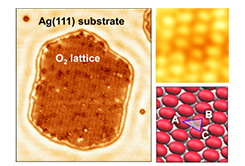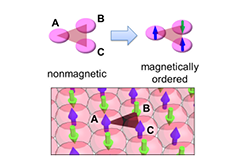Oxygen Molecules Physisorbed on Ag(111) Surface: A two-dimensional Quantum Spin System
Y. Kim, Y. Yoshida and, Y. Hasegawa
An oxygen molecule (O2) is one of the smallest molecular magnets with an S = 1 quantum spin, and thus an building block for attractive low-dimensional quantum spin systems, i.e., quantum spin liquid phases and the Haldane phase. Recent development of scanning tunneling microscopy (STM) and spectroscopy (STS) has enabled direct access to the properties of single atoms and molecules and even their manipulation to fabricate artificial nanostructures, providing an ideal playground for bottom-up fabrication of the low-dimensional spin systems.

Fig. 1. (left) STM image acquired on O2/Ag(111) at 4.7 K. An island structure is observed as a a depressed area. (upper right) Molecular resolved STM image in an O2 island, (lower right) Schematic of O2 lattice (red ellipsoids) on Ag(111).

Fig. 2. Lattice distortion induced by antiferromagnetic ordering. The blue and green arrows denote the directions of the O2 spins.
A well-known problem for O2 adsorption on a substrate is that O2 often loses its spin through the strong interactions with the substrate. However, it has been reported that the interaction between the physisorbed O2 and Ag(111) surface is substantially weak and that structures almost identical to solid oxygen phases can be realized on the surface. Here we report the direct visualization of O2 physisorbed on Ag(111) by using low-temperature STM/STS. Physisorption of the observed monolayer O2 islands was confirmed by their thermal stability. We observed a well-ordered O2 structure and found that the lattice was slightly distorted from an isosceles triangular shape, which can be explained by the presence of the exchange interactions between the O2 spins. No Kondo resonance was observed in the differential tunneling conductance (dI/dV) spectra. Based on these observations, we conclude that the system is an S=1 two-dimensional antiferromagnetic quantum spin system
Figure 1 shows an STM image of O2 on Ag(111) taken at 4.7 K. Because of the reduced local density of states monolayer O2 island structures are observed as a depressed area. After the sample annealing up to 40 K, most of the O2 islands disappeared, indicating physisorbed nature of the adsorbed molecules. The upper right panel of Fig. 1 shows a molecular-resolved image of the O2 layer that exhibit a well-ordered lattice structure. One of the peculiar things we found is that the molecules form a scalene triangular lattice (i.e., AB < AC); the dimensions of the O2 unit cell were measured as AB = 0.421 nm and AC = 0.435 nm based on real-space STM images taken on three different O2 islands.
Since the O2 lattice was incommensurate with the Ag(111) substrate, the surface corrugation of the substrate affects the O2 lattice only as random perturbations, and thus does not seem to affect the shape of the O2 lattice. Actually, an almost identical scalene triangular lattice was reported for low-coverage phase of O2 physisorbed on HOPG, which is also incommensurate to the substrate. The similarity of the O2 structures on two different substrates indicates that the distorted lattice structures are intrinsic to the O2 molecules.
There should be some reason for the lattice distortion observed in the physisorbed O2 layers. Here we considered exchange interactions between the O2 spins. The energy of the exchange interactions between the O2 spins was estimated as ~6 meV from the magnetization of solid oxygen. This was less than the van der Waals interactions (~30 meV) but significant enough to contribute to the total energy of the system. Indeed, the high-coverage phase of O2/HOPG and solid oxygen showed lattice distortions coinciding with antiferromagnetic ordering, which indicates that the softness of the O2 lattice allows the magnetic interaction to be involved in the lattice formation. With the magnetic ordering, the system can be stabilized by shortening the sides of the isosceles triangle at which spins are antiferromagnetically aligned, as schematically shown in Fig. 2. In order to confirm the scenario, we performed Monte Carlo simulations for the 2D freestanding O2 lattice. Using a set of the parameters that were used for the high-coverage phase of the O2/HOPG, we successfully reproduced the distortion, confirming the validity of the scenario. We thus concluded that the antiferromagnetic ordering of the O2 spins played a crucial role in the distortion of the O2 lattice on Ag(111).
In order to verify the preservation of the intrinsic S=1 spin of O2 on the Ag(111) surface, we also checked the dI/dV spectra taken on the O2 island and observed no specific evidence of the Kondo resonance around the Fermi level, in stark contrast with the case of O2 molecules on Ag(110), which exhibits a clear Kondo resonance at 18 K. The O2 spins are thus little influenced by the itinerant electrons of the substrate, and would be expected to form an S = 1 quantum spin system. These results imply that our system is an example of a 2D S = 1 antiferromagnetic quantum spin system and the potential for a brand-new approach of constructing low-dimensional quantum spin systems in a bottom-up fashion.
References
- [1] S. Yamamoto, Y. Yoshida, H. Imada, Y. Kim, and Y. Hasegawa, Phys. Rev B 93, 081408(R) (2016).
